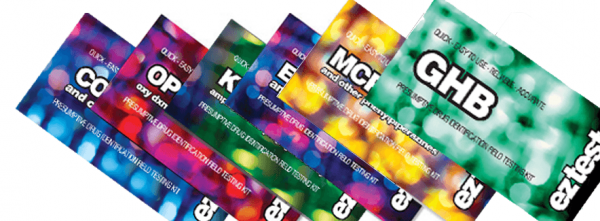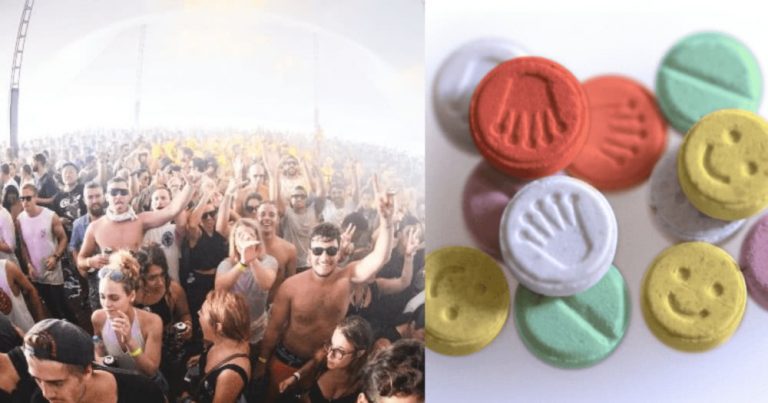For many music festivalgoers, drugs are a significant part of the festival experience. But we all have a responsibility to make the experience safer, writes JOSEPH EARP.
How to deal drugs at festivals
It was summer 2011 and I was at a sold-out English music festival with a drug dealer. He was a little older than me, somewhere in his mid-20s, and spoke in a thick South London accent. His mum was from Haiti, his dad from Coventry, and he had spent the last few years slowly working his way around the country, making his living selling pills and playing pool for money.
“It’s whatever, you know. Like as an actual job,” he explained. “It’s good in its own way. It means a lot of parties, yeah? And meeting a lot of new people.”
Let’s call him Pete, although that wasn’t his name. We’d met online, a few days before the festival. I was looking for a ticket and he was selling one; he and his long-term boyfriend had split up a few weeks earlier.
Chatting online, we’d decided we would meet in front of the festival entrance. I’d grab the ticket off him, give him the cash, and then we’d part ways. I was happy to walk around the festival by myself; I liked going to shows alone, and certainly wasn’t interested in spending a day in a hot English field with a total stranger. I had difficulty enough talking to friends, let alone a 20-something in a fluoro orange bucket cap who wouldn’t stop calling me Jose. But Pete wasn’t having any of it.
“What the fuck, man?” he kept saying, loudly. “You’re gonna do this by yourself? Like fuck, man. You’re gonna come with me. We’re gonna hang.” When I didn’t immediately respond, too slow to think of a good enough excuse, Pete just shouted louder. “We’re gonna hang,” he bellowed.
There was a little headphone popped into Pete’s left ear, and there it stayed the whole day. I guess he was listening to music – that might explain the shouting, and the occasional little twists and pirouettes he’d do, his body seizing up in dance, apropos of nothing – but before long I realised it was ridiculous to assume anything about Pete.
For a start, even though he was at the festival ostensibly to get rid of the packed condom full of pills currently jiggling against his colon, he swore he didn’t actually do drugs himself. “Fuck no,” he said. “Especially not pills. Shit’ll kill you. Shit’s garbage.”
But he didn’t seem to have any ethical qualms about providing drugs to others. Nor did he seem to feel the need to be particularly subtle about his transactions. He’d walk up to a throng of people, nod, maybe flirt a little if there was a good-looking guy in the group, and then ask if anyone wanted some E. It was an electronic festival, so the answer was invariably yes.
Once or twice, people assumed that Pete was offering freebies. “The fuck, man?” he’d say, when the punters stared at Pete’s open palm in confusion. “Money? You got money? You think I’m some kind of fucking charity?”
But breakdowns in communication aside, the reception Pete received was rapturous. For the most part, he was like some conquering hero; a saviour, come to free everyone from their sobriety. He’d pocket the punter’s cash, his body pressed up close to theirs, and then palm them one of the pills he’d already transferred from his rectum to the right pocket of his khaki shorts. The look on their faces. You’d think they’d won the lottery or something.
And as the day wore on, Pete only became more important to people. Keen to avoid the attention of the festival’s limited police presence, a lot of punters had popped their pills before leaving home, and now they were sobering up, snapping cruelly back into sobriety in the middle of a sun-blasted, overcrowded field. For these poor sods, Pete was a miracle.
“I can’t believe it,” one guy said, holding a pill in the palm of his hand, staring at the thing with eyes as big as saucers.
“Christ,” said Pete, bouncing into the punter and closing his hand around the pill for him. “Put it away.” The display had been a little too unsubtle, even for Pete.
Money? You got money? You think I’m some kind of fucking charity?
I learnt a lot that day – things that I guess should have been self-evident. But I wasn’t really a festivalgoer, and definitely not someone who had ever been interested in pills. They looked a little grotty to me, and the people on them looked a bit that way too, their mouths twisting into little tensed up spirals of flesh, their eyes impossibly wide. Why would anyone want to be that fucked up, I’d always wondered. Why would anyone want to be that out of it?
Of course, I was happily drinking – and drinking too much – while denigrating all those pill-poppers. I didn’t even bat an eyelid when walking past a shirtless man lying spread-eagled on the ground, a delicate trail of spew arcing out of his mouth and onto the grass beside him, his whisky-addled body still twitching a little. But Pete did.
“Y’know how much he paid to do that to himself?”
It was a gripe shared by many. The festival organisers seemed happy for punters to get fucked up in ways that they could profit from. After all, the drink prices were toe-curlingly steep, and pop-up bars dotted the grounds like pockmarks.
None of the bartenders seemed to be telling people when they’d had too much either, and so soon it was the drunkards causing trouble, not the pill-poppers. It was the broad-shouldered, alcohol-sodden guys that were starting fights, circling predatorily around the women in the front row, and passing out on the grass like pigeons swollen with rice. Those high on pills didn’t exactly keep to themselves, but they weren’t looking for fights, either. They were happy to keep to themselves, bopping about the front row, climbing onto their friends’ shoulders, hooting words of encouragement at the musicians.

It wasn’t an idyllic scene, of course, and particularly towards the end of the day, when the sun started to set and the E comedown kicked in, a lot of punters faded both fast and messily. The piles of puke began to accumulate. Gurners, their high fading and desperate for water, began sculling litres of the stuff at a time.
But even still, it wasn’t an apocalyptic scene. The festival didn’t transform into some fallen garden of Babylon, a den of drug abuse and disarray and despair. It was just a field somewhere in the middle of England, lit by dwindling light, in which a bunch of young people slowly came fluttering down.
Pete looked rather pleased with himself. He’d sold all the pills, and netted himself a tidy little profit. But more than that, he’d helped people have a good time. He wandered the grounds and I followed him, stumbling a little, full of too much expensive beer.
“A good day,” he said, wiping his hand across his hot brow. “A good day.”
On the way out, we passed a small throng of security guards, their backs stiff, eyeing the retreating crowd.
“Thanks lads!” Pete bellowed at them, a smile of coy satisfaction spreading across his face. The security guards just glared.
—
It’s been six years since that festival. Some things have changed, but a lot of things haven’t. There are more cops, of course, particularly here in Australia, where police presence at festivals is strident. Pete wouldn’t have gotten away with wandering through Laneway or Splendour as conspicuously as he did that day in the UK – the sniffer dogs would have got him, or the small army of security guards that clog up festival gates. And he certainly wouldn’t have been able to conduct drug deals out in the open, exchanging pills for cash left and right.
But festivals and drugs – pills, in particular – are still synonymous with one another. And for the same reasons, too. The price of alcohol at events has only gone up as of the last few years, and even those who have no intention of taking illegal drugs have to be covert about their use of the legal ones. You might not want to pop a few eccies, but unless you’re looking to stand in a patience-testing queue only to shell over a small fortune to get a few flat beers, you’ll be compelled to bend the rules too, smuggling in bottles of vodka decanted into water bottles.
“You really get left with no options,” one young anonymous festivalgoer explained to the BRAG. “If you want to stay totally sober, you’re fine, but if you want to take anything – even legal stuff like ciggies and booze – then you’re fucked. They really leave you with no choice. It’s like you have to get fucked up in dangerous ways, otherwise you’ll get in trouble. And that’s where the bad shit happens.”
The reality is, five years ago it didn’t cost $12 for one drink.
Hence why punters pre-drink, sometimes downing half to a whole bottle of spirits before they even leave home. Hence why punters do the same with drugs. Hence why punters go to extreme lengths – excessive lengths, dangerous lengths – just to have a good time.
“I think a lot of the reason why drugs have become so much more popular over the last five years is to do with the price of alcohol,” explains Trent to the BRAG. And Trent would know: he works for one of Australia’s most successful pill-testing kit companies, EZ Test. “The reality is, five years ago it didn’t cost $12 for one drink. And for kids of 22 years of age, they just don’t have the funds like people might have had once upon a time. They’re just looking for something – just looking to enjoy themselves.”
And that, almost without exception, is what punters do end up doing: they enjoy themselves. That is their aim. Most people don’t want to get fucked up, or to drink so much they black out, or to load up on so many drugs that they can’t process the music that they’re there to see; can’t feel safe. “What nobody seems to get though is that people don’t go to a music festival intending to die,” explained a young person named Julie to the Sydney Morning Herald. “They go to get high, to have a good time in the sun with their friends.”
Indeed, a lot of those who pop pills at festivals do so in that setting and that setting alone – they are not the opportunistic drug delinquents that some politicians and puritanical crusaders paint them to be. They’re just young people looking for a dance; looking to have a good time with their mates in a relatively safe, relatively well-staffed environment. “You just want to dance and feel the music and you feel really good for a little while and it’s a different feeling completely to being drunk,” a woman identified only as Sarah said to The Vocal.
That’s not to be coy and pretend that Australians don’t have issues with drugs, and especially pills. “In 2015, the Australian Institute of Health and Welfare’s National Drug Strategy Household Survey reported 27 percent of Australians aged 20-29 had used illicit drugs in the preceding 12 months, with eight percent having used ecstasy in that period,” read a Huffington Post story. “The 2014 United Nations World Drug Report found Australians had the highest rate of ecstasy consumption on Earth.”
So it would be wrong to pretend that pills are something we only pop at music festivals – clearly, Australia’s issues with drugs go deeper than that. But that doesn’t necessarily mean we should start conflating the casual use of drugs that goes on at festivals with deeper, more systemic drug abuse problems and crime.
Drugs, no matter what the trumped-up boomers who have the public discourse in a stranglehold might suggest, are not to be simplified, or demonised, or reduced to worrying statistics. When we talk about drugs, we are talking about a complex, diverse product that has come to mean many things to many people. And to break down that narrative into a vague, sensationalised series of anecdotes that can then be used to neglect the voices of those that actually use drugs isn’t just foolhardy; it’s actively dangerous.
The rising toll
“Five people died after consuming illegal narcotics at a music festival in Argentina last year. In 2015, two people died from drug overdose at Live Nation’s Hard Summer. That same year, one died at Beyond Overland, another at Electric Daisy Carnival, and another at TomorrowWorld.” – Digital Music News
Georgina Bartter was only 19 years old when she collapsed onto the floor at Sydney’s Harbourlife festival in 2014. Friends told the police officers who arrived at the scene soon after that Bartter had taken no more than a single pill – maybe, at a stretch, a pill and a half. A little later it was discovered that another 19-year-old had sold the ecstasy to a third-party agent who had in turn passed it on to Bartter. When Bartter, suffering from massive organ failure, later died in hospital, the dealer was charged.
The pill Bartter had taken was called a “purple speaker”. The media, seizing on the story, began to interrogate other teenagers who had taken the drug. “Way too good, the best I’ve had in years,” was how one young user explained the pill’s high in a blog post later picked up by the Daily Mail Australia. The Mail used the quote for a headline, filling the story with alarming descriptions of Bartter’s collapse and the grief of her parents and the punters who tried to help her. It was a horror story, but a horror story very much of the time; almost every other paper was running a shocking tale of its own.
“The media has been right on this,” Trent says of the drug-related hysteria that has gripped the media over the last few years. “I think it’s the 24-hour news cycle; I think that’s a big part of it. People have been writing about it because there’s not a lot else to write about. That element has come into play. When something does go wrong, it is quite a hot topic – and not just in the online press, but in radio talkback and the rest of it.
“I think the older generation is the issue. They don’t really understand why people take [drugs] I guess. But because drugs have become so much more popular over the last five years, they now realise that something has to be done to stop the deaths.”
These days, pills are described like secret weapons to be sold on the black market; like cocked guns, waiting to go off. Sites like the Mail traced the lineage of the “purple speaker”, suggesting the potent pill might have originated somewhere in Sweden. And their articles were filled with grainy, grim pictures of the pills, photographed against grungey walls, or the cupped hand of a user.
The same year that Bartter passed away, a young pharmacist named Sylvia Choi died after taking ecstasy and MDMA while attending the Stereosonic music festival. “I’m not feeling my high,” she told her boyfriend, according to a story published by the SMH. “Five hours later, the 26-year-old from Oyster Bay in Sydney’s south was dead,” read the story.
If the hysterical, frenzied tone of the media was extreme before Choi’s passing, it only got more so afterwards. Soon, a witch hunt was under way – before too long, the festivals themselves were being blamed, and numerous allegations began to whip through the media like wildfire. “One Stereosonic security guard allegedly took the drug GHB while on duty and needed to be taken to hospital,” ran a story posted to The Daily Telegraph.
Eager to shake the blame, festival organisers began to shift the onus of responsibility onto crowds themselves. “According to the Stereosonic founder [Richie McNeill], one of the biggest problems is that festival staff neither have the physical nor legal power to thoroughly search and arrest punters; something which is exacerbated by Australia’s ‘steroid issue and ‘gym hulk’ mentality’,” read a line in an article posted to Music Feeds.
Where there could have been a reasonable, respectful discussion about the ways to halt the tide of drug-related fatalities, there was instead a screaming match.
The same old voices began clogging up the airwaves, too. Police commissioners condemned the “depraved” dealers, while politicians like New South Wales’ own Mike Baird rushed to tell the public that “enough is enough”. Baird’s answer to Bartter’s death, and indeed to the spate of other drug-related fatalities around the country, was to suggest mass arrests, an increase in the prevalence of sniffer dogs, and, perhaps most stridently, to threaten the ability of festivals to host gatherings on public land.
“Individuals need to take responsibility for their actions, but so do the organisers of these festivals,” he said. “In the light of [these] distressing and avoidable incident[s], I will be asking the relevant ministers to review the current system of regulating events held on public land, including the system for granting permits for public events such as music festivals.”
It was pandemonium. And in that pandemonium, the quietest, most sensible voices got lost. No matter that many of the politicians who called for sweeping arrests and an increase in police presence were being actively refuted by experts, and those who had dedicated their lives to saving the lives of drug takers. No matter that the media turned to those in power for advice, rather those with hands-on experience of festival culture and drug use.
As a result, where there could have been a reasonable, respectful discussion about the ways to halt the tide of drug-related fatalities, there was instead a screaming match. And where there could have been debate, there was demonization.
What the future holds
The hardline approach does not work. That has been proven by now. You cannot stop the drug problem by waging war on it, just as you cannot stop something as ephemeral as “terror” by pledging to fight it with guns, and with arrests, and with the restrictions of civil liberties. Turning drug users and drug dealers into the enemy is like cutting off your toe to avoid the worst of tinea; like murdering your children to make sure someone else doesn’t first.
“It simply doesn’t work,” says Trent. “The more you tell someone they can’t have something, the more they want something. And that’s not just true of drugs, that’s true with a lot of things. That’s true with relationships, with anything. That’s just a human reaction in itself.”
Trent is just one of many voices involved with the production and popularisation of pill-testing kits. For the kits’ defenders, their widespread distribution would provide a practical, concrete way to avoid the dangers associated with drug-taking at festivals. After all, the majority of drug-related deaths occur when users are in the dark about what they’re actually taking; when they pop Ritalin, instead of E, or find their drugs are purer than they are used to.
As a result, for Trent and those who support his cause, pill-testing kits would not be a way of legitimising drugs; they would just be a way of ensuring that those who take them can do with a minimal risk of harm.

“Using drugs is never without risk,” Will Tregonning of the pill-testing advocacy group Unharm told Huffington Post. “Using unknown drugs is much riskier. If this continues, more young people will die. It’s as simple as that. People are going to use drugs anyway, not knowing what they’re taking. We want to provide that at risk group of people, already about to use drugs, info about the drugs they’re intending to consume, and give them info around the risks of consuming that substance.”
Perhaps most persuasively of all, the success of such an approach has already been at least in part proven. Several festivals in Europe and the UK have already adopted the use of pill-testing kits like the ones EZ Test sells, and the results are speaking for themselves.
“There is clear evidence from research conducted across Europe that [pill-testing] has the benefits of sharply reducing risk, changing negative behaviours and ultimately saving young peoples’ lives,” a young man only identified as Jake told the SMH. “I find it appallingly hypocritical that in a country such as Australia, where we spend hundreds of millions of dollars annually on an inhumane border policy to supposedly ‘save lives at sea’, we aren’t prepared to take even the most elementary of steps in trying to save the lives our own youth.”
By contrast, the argument against pill-testing is mostly based on moralising and on fear. The NSW Government, and particularly the NSW Government when it was led by religious extremist Baird, was stridently against the possibility of letting punters know exactly what was in their pills. “A spokesperson for NSW Police Minister Troy Grant [said] no test could guarantee the safety of an illegal drug or its effect on an individual,” reported the ABC. “’The NSW Government will not facilitate or sanction the testing of illegal drugs, creating the dangerous fiction that they are then safe to consume,’ the spokesperson said.”
You cannot stop the drug problem by waging war on it.
Yet such an argument is ignorant at best and wilfully, deliberately obtuse at worst. Pill-testing kits do not aim to normalise drugs, or convince those who take pills that their drug experiences will be certifiably safe. Rather, they are about stopping deaths. They are about education. They are about making sure Australia’s young people are not forced to trust their dealers rather than scientists; about giving them the most information possible. “It is good practice to suggest that we never tell them that the drug is good or safe, merely tell them what’s in their drug and contextualise it for their consumption,” Dr. David Caldicot, a prominent supporter of pill-testing, told the ABC.
It is promising, then, that those working at the ground level to halt the flow of drug-related deaths feel as though change is coming. And a lot of that, Trent explains, comes down to the developments in the test kits themselves.
“There’s a lot more range with the kits these days,” he explains. “We have cocaine testers that just didn’t exist back in the early 2000s. The names of the kits have changed, too; they used to be named after the reactants that they used in the test, whereas now they’ve streamlined and they have named them after the drug they’re testing for. That’s been done for a lot of brand awareness; to streamline the product. Obviously before when you had products called stuff like Mandalin … it wasn’t very self-explanatory as what they were. So it has evolved quite a bit.”
A few decades ago, Trent says pill-testing kits were “almost in the same category as the drugs themselves. Back then, anything to do with drug testing was considered not a good thing. Whereas these days it’s clear people would rather do this than nothing. Now tobacconists are selling them. A lot of people are selling them that would never have sold them prior. That’s a fairly obvious sign that the stigma is going.”
Clearly, we need to shift our thinking. We cannot merely sit back and cling to our staunchly anti-drug policies while young people are dying. We need to compel our politicians to think and act in a way that supports the needs of millennials, rather than just the rabid, hysterical shrieks of media-addled boomers. And we need to do it soon.

































